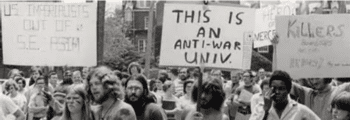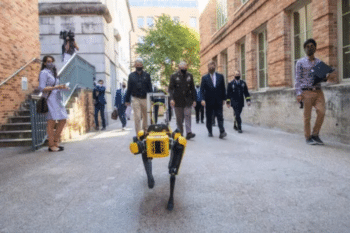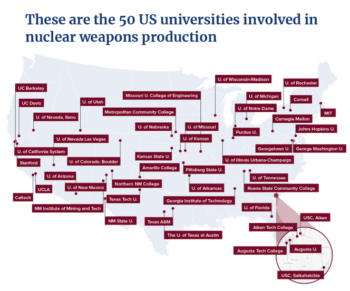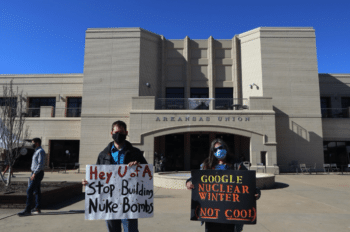Once upon a time getting a college degree meant reading classic literature and philosophy, learning about history and politics, studying mathematics and science, learning new languages, and debating the great issues of the day in student forums.
The billionaire class and Pentagon, however, do not want young people to think critically, or to be worldly and idealistic.
They want the university to function as a breeding ground for creation of a docile, technically skilled workforce that they can control, and as a laboratory for the development of new weapons systems and testing ground for those weapons that can help them dominate the world.
Recolonizing the Campus

Michael T. Klare [Source: kgvm.org]
Klare warned about the Pentagon’s drive to recolonize American universities and exploit academia’s expertise for the development of new weapons, including hypersonic and robotic weapons.
According to Klare, the military-industrial-academic complex first emerged during World War II and was expanded during the Cold War when the Pentagon developed a significant presence on American campuses.
Among other things, it financed academic research in nuclear physics and radar and missile technologies, and helped to develop the hydrogen bomb along with many other weapons systems that caused methodical devastation in the Korean and Vietnam Wars.

[Source: gabybenavidezcounterculture.weebly.com]
However, since the declaration of the War on Terror and new great-power competition with Russia and China, the Pentagon is now moving back on campus with limited pushback as the government attempts to wage an “all-society struggle” to ensure U.S. military supremacy.
Developing the Weapons of the Future

Ceremony honoring partnership between U.S. Army Futures Command and the University of Texas at Austin. [Source: utsystem.edu]
In May 2019, the University of Texas Board of Regents approved $20 million to support this collaboration, in addition to $30 million UT Austin was committing to strengthen faculty and research capabilities in areas of mutual interest with the Army.
Part of the $20 million was being used to construct a since-completed robotics research center in the Anna Hiss Gymnasium, where students and faculty members work alongside Army personnel in helping to develop cutting-edge robotic weaponry.

A four-legged robot leads way to visiting Army and state government officials outside new robotics research center on the campus of the University of Texas at Austin. [Source: news.utexas.edu]
The U.S. Air Force has also recently entered an AI-focused research partnership with the Massachusetts Institute of Technology (MIT), the “Pentagon on the Charles,” whose faculty have recently been involved in the creation of insect-sized drones, and a body armor suit that would give soldiers powers straight out of a Marvel comic.
Under the $15 million per year agreement, known as the MIT-Air Force Accelerator, which is a component of the new MIT Stephen A. Schwarzman College of Computing, eleven airmen were picked to work in a research and development collaboration team intended to deploy practical AI solutions for “real-world, national security challenges.”
A new program at MIT also funded by this initiative aims to teach U.S. Air and Space Force personnel to understand and utilize artificial intelligence technologies.
Schools of Mass Destruction

MIT Professor of Mechanical Engineering Gareth McKinley is helping the Pentagon to develop a high-tech suit for soldiers à la “Iron Man.” [Source: livescience.com]
Among them is the University of Arkansas, whose engineering department, as CAM previously reported, signed a collaboration agreement in 2017 with Honeywell International, which produces 85% of the non-nuclear components of nuclear bombs in the United States.
Honeywell had earlier been a target of protesters in the 1960s because of its producing lethal anti-personnel bombs that killed tens of thousands of civilians during the Indochina Wars.
The Minnesota-based company has initiated at least ten master collaboration agreements with universities since 2015 for the purpose of “facilitating closer collaboration on research and development of new technology to meet national security needs.”
Funding from the Department of Defense to higher education institutions overall has increased by more than 60% in the past 30 years.

[Source: icanw.org]
Hosting a Combat Center Named After a War Criminal
Texas A&M University’s RELLIS campus, located an hour outside of Austin, Texas, looks much more like a military base than a university.
In 2020, the Texas A&M University System Board of Regents approved $79.3 million in university funding to create a new hypersonic weapons test center for the U.S. Army Futures Command dubbed the George W. Bush Combat Development Center.1
Named after a war criminal who presided over illegal wars that led to the deaths of well over one million people, the center includes a kilometer-long enclosed tube used for hypersonic weapons tests, along with testing grounds for air and land combat vehicles.
The campus had already been used to test other priorities for Army Futures Command such as autonomous land vehicles. It currently features “laboratories, runways, underground and open-air ranges and a resilient network of sensors and systems for experimentation, data collection, analysis and storage,” according to a university release.

Protesters in front of the University of Arkansas Student Union on January 22, 2021. [Source: Photo courtesy of Pauline Mtpl]
Georgia Tech and Lockheed Martin
A second speaker at the April 5 webinar, journalist Indigo Olivier, discussed an article she wrote for In These Times about Georgia Tech and Lockheed Martin, the number one employment recruiter on campus. Lockheed houses four university laboratories that have worked on Black Hawk helicopters and the F-35 jet on its aeronautics campus in Marietta while developing a collaboration on hypersonic missile research.
Olivier wrote that,
if you’re an engineering student at Georgia Tech, Lockheed is omnipresent. You may run into Lockheed’s recruiters at career fairs or in the lobbies of the Student Success Center, the School of Electrical and Computer Engineering or the College of Computing. They may be hosting a seminar on space exploration in the Clary theater…or sponsoring challenges and awarding prizes to students during ‘Engineering Week’ or hosting workshops where teams use Minecraft and Lego bricks to explore the future of digital work.

Indigo Olivier [Source: conversationalist.com]
You’ll see Lockheed’s logo displayed on the career center’s website and job portal alongside such other corporations as ExxonMobil, Capital One and The Home Depot—just one of Lockheed’s privileges as a member of the university’s Corporate Partnership program. As an Executive Partner, Lockheed is provided with interview rooms, consultations with the school’s employer relations team, and access to an online resume book featuring current students and recent graduates. Georgia Tech also assists students with a Lockheed cover letter template. And of course, there’s Lockheed Martin Day [when] they show off flight simulations and you might give a recruiter your résumé and they might give you an interview.
Reflecting Distorted National Priorities
Lockheed’s deep research into higher education reflects national priorities. Since 9/11, the U.S. has spent $8 trillion on war. In 2020, for the first time, federal funding to Lockheed surpassed that of the U.S. Department of Education, the federal agency tasked with dispensing scholarships and Pell grants.

[Source: atlanta.curbed.com]
According to Michael Klare, the Pentagon has made the calculation that it increasingly requires the expertise of academics to help it sustain a military-technological edge over Russia and China, whose governing bureaucracies directly employ top scientists.
And universities—desperate for cash in an era of neo-liberal budget cutbacks—are eager for the revenue that the military can provide.
The flip side of all this, Klare said, is the exploitation of scientific and technological discovery for nefarious purposes, and distortion of the academic mission, which is to foster the “open exchange of ideas for the benefit of humanity.”
Where Is the Resistance?

1968 student strike at Columbia University—which was in part over the university’s ties to a Pentagon-affiliated think tank. [Source: nytimes.com]
When asked whether there was any movement against the militarization of higher education, Klare said that, apart from some small and scattered campus groups, he was unaware of any.
Klare was part of the 1968 Columbia University uprising, which targeted President Grayson Kirk’s relations with corporate industries that profited from U.S. military interventions, and the university’s relationship with the Institute for Defense Analysis (IDA), a weapons research think tank affiliated with the Pentagon which worked on projects related to the Vietnam War.2
Around the same time, Students for a Democratic Society (SDS) led sit-in demonstrations at MIT’s Draper and Lincoln Labs, which worked on guided and anti-missile missiles in contracts with Raytheon Corporation, and projects suitable for guiding “smart bombs,” Multiple Independently Targeted Reentry Vehicles (MIRVs), and fire and inertial navigation systems used to stabilize the flight of helicopter gunships and later of cruise missiles and drones.3
Joel Feigenbaum of the Science Action Coordinating Committee (SACC) urged MIT’s students at the time to perceive the connection between “our sparkling, expensive laboratories and the instruments of death produced by the fellow next door. We [students] cannot live comfortably in a place such as MIT which declares it is apolitical while producing MIRVs, ABMs [Anti-Ballistic Missiles] and weapons for Vietnam.”4
Students today, unfortunately, have been able to live comfortably at MIT and other campuses producing death instruments that would have once seemed conceivable only in science-fiction novels.
A key reason is the absence of a draft and the fact that campus activism has been channeled into culture wars and identity politics.
If the new Cold War escalates and students increasingly feel threatened by the prospect of nuclear war, then renewed campus anti-war activism may yet re-emerge—hopefully before it is too late to save our species from the weapons developed by all those bright men and women with Ph.D.s.
Notes:
- ↩Hypersonic missiles travel five times the speed of sound for as many as 3,500 miles.
- ↩These projects included the development of the electronic battlefield, a ring of censors along the Ho Chi Minh Trail connected to air bases in Thailand, which when set off would trigger bombing attacks.
- ↩Susa Bridger, Scientists at War: The Ethics of Cold War Weapons Research (Cambridge, MA: Harvard University Press, 2015); Michael Albert, Remembering Tomorrow: From SDS to Life After Capitalism-A Memoir (New York: Seven Stories Press, 2006); Jon Nordheimer, “Protests Disturb Lab Men at M.I.T.,” New York Times, November 9, 1969, 61; Bob Park, “Raytheon: The Tip of a Stolen Iceberg,” Science for the People, Vol. III, No. 3, July 1971, 14-18, 26. In May 1970, MIT divested itself of the Draper Lab in a triumph for anti-war forces, though President Howard W. Johnson retained the Lincoln Laboratory. At Stanford, students during this era burned the ROTC building, fire-bombed the president’s office, and blocked traffic around the Stanford Research Institute (SRI), a government and Bechtel Corporation-funded high technology scientific research organization connected to the Defense Department and its affiliated Applied Electronics Laboratory, which students occupied. The protests occurred after demands had been issued to halt all classified research including into Air Force reconnaissance and surveillance systems and chemical and biological warfare. Student radicals later stormed the university’s computational center which ran simulation programs used by helicopter and gunship pilots. English Professor H. Bruce Franklin was fired for having urged students to “shut down the machinery of war,” with the protesters causing $800 worth of damage. Richard Lyman, Stanford in Turmoil: Campus Unrest, 1966-1972 (Palo Alto, CA: Stanford University Press, 2009).
- ↩Kelly Moore, Disrupting Science: Social Movements, American Scientists, and the Politics of the Military, 1945-1975 (Princeton, NJ: Princeton University Press, 2008), 144.

